|
|
|
A Classification of Eye and Gaze Movement Parameters
Matthias Roetting, Ph.D.
Liberty Mutual Research Institute for Safety
71 Frankland Road
Hopkinton, MA 01748
Phone: (508) 497-0237
Email: matthias.roetting@libertymutual.com
|
| |
|
Overview
|
|
| |
|
Eye and gaze movement parameters
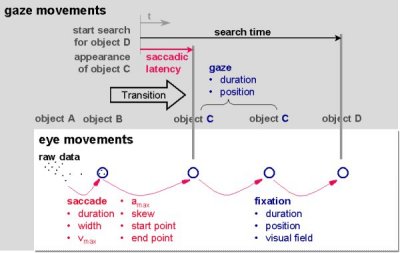
cf. Rötting, 2001
|
|
| |
|
Parameters of a saccade
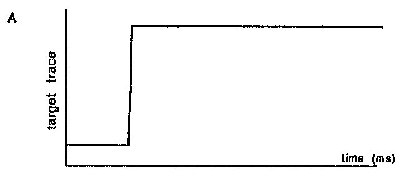
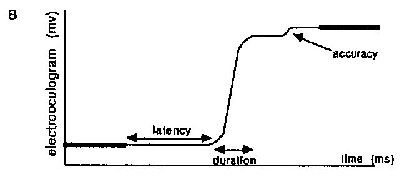
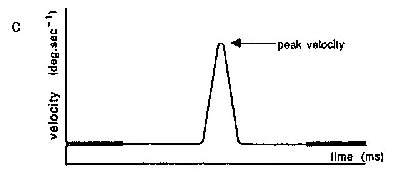
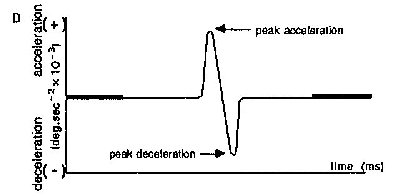
Glue, 1991
|
|
| |
|
Fixation durations

cf. Rötting, 2001
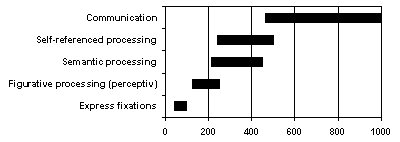
Velichkovsky et al., 1997
|
|
| |
|
Catalog of parameters
cf. Rötting, 2001
- Name
- Definition and operationalization
- Common values
- Discussion
- Variation and similar parameters
| Raw Data |
2 |
Saccade parameters
(Occurrence, Temporal, Spatial, Temporal and spatial) |
12 |
Fixation parameters
(Occurrence, Temporal, Spatial, Temporal and spatial) |
13 |
Scan path parameters
(Temporal, Spatial, Temporal and spatial) |
17 |
| Combined parameters |
3 |
| Sum |
45 |
|
|
Parameter classification
Time Scale of Human Action
| |
Scale (sec) |
Time Units |
System |
World (theory) |
| |
107 |
months |
|
SOCIAL BAND |
| |
106 |
weeks |
|
| |
105 |
days |
|
 |
104 |
hours |
Task |
RATIONAL BAND |
| 103 |
10 min |
Task |
| 102 |
minutes |
Task |
| 101 |
10 sec |
Unit Task |
COGNITIVE BAND |
| 100 |
1 sec |
Operations |
| 10-1 |
100 ms |
Deliberate Act |
| 10-2 |
10 ms |
Neural Circuit |
BIOLOGICAL BAND |
| 10-3 |
1 ms |
Neuron |
| |
10-4 |
100μs |
Organelle |
cf. Newell, 1990
|
|
| |
|
Level concept of ergonomics
 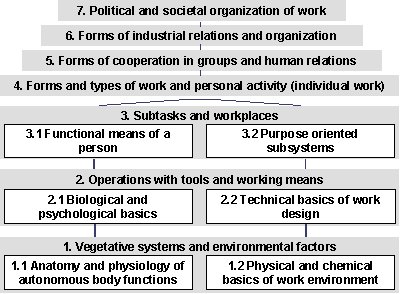
Luczak, 1997 |
|
| |
|
Models guiding ergonomic task analysis
| Level |
Focus |
| 7 |
Use of analytical knowledge from task analysis for societal purposes |
| 6 |
Inner-company and inter-company organizational determination of task structures |
| 5 |
Task structure and group organization |
| 4 |
Combination of tasks to a job |
| 3 |
Single- and multi-tasks in human-machine interaction |
| 2 |
Time consumption |
| 1 |
Physiological costs |
Luczak, 1997 |
|
| |
|
Eye and gaze movement parameters
Level 1 - Determination of physiological costs
- Changes in arousal
- Fatigue and vigilance
- Changes in visual field
- Changes due to secondary task
- “Cost” of moving the eye
Level 2 - Explanation, calculation and prediction of times
- Duration of information acquisition and information processing
- Duration of transitions
- Duration of search
Level 3 - Analysis of Human-Machine-Interaction
- Analysis of spatial layout
- Analysis of search processes
- Analysis of information acquisition and information processing
- Analysis of levels of processing
|
|
| |
|
Examples
Level 1: changes in arousal
Mental arithmetic
"Rejection of the environment" (Lacey, 1959)
Identical set of three-digit numbers (e.g. 526)
- Easy task: dividable by 4?
- Difficult task: dividable by 3 and/or 4?
Mean fixation duration
- Easy: 792 ms
- Difficult: 1,504 ms
Driving
"Environmental intake" (Lacey, 1959)

Unema & Rötting, 1990
|
|
| |
|
Level 1: secondary task influence
Entropy Rate
- Degree of regularity or randomness of the viewing behavior
- Based on the first order (pairs of fixations) and sometimes the second order (triples of fixations) transition frequencies

- The entropy rate of the Conventional VSI without a secondary task is equal to the Vertical VSI with a secondary task every 22 seconds
cf. Harris et al., 1982
|
|
| |
|
Level 2: duration of infomation acquisition
Comparison of two driver navigation systems
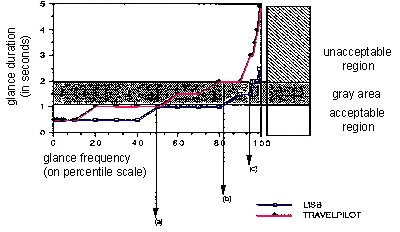
Fairclough et al., 1993; cf. Zwahlen et al., 1988 |
|
| |
|
Level 3: relative number of fixations
Bus

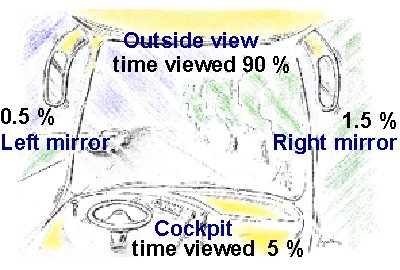
Combine harvester

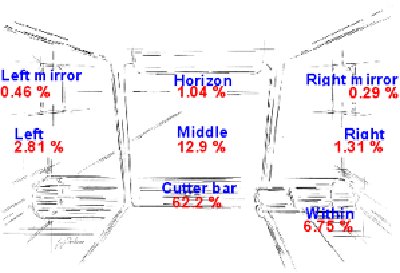 |
|
| |
|
Level 3: information acquisition
Statistical analysis of transition frequencies

cf. Ellis & Smith, 1985
|
|
| |
|
Application of the classification
Transportation research at LMRC

|
|
| |
|
Which eye movement parameters can be used to quantify distraction?
- Distraction ≈ Involuntary attendance to a secondary task
- All parameters that reflect "changes due to a secondary task" can be used to quantify distraction
- Transition frequency
- Autocorrelation
- Entropy
- Markov matrices
|
|
| |
|












































